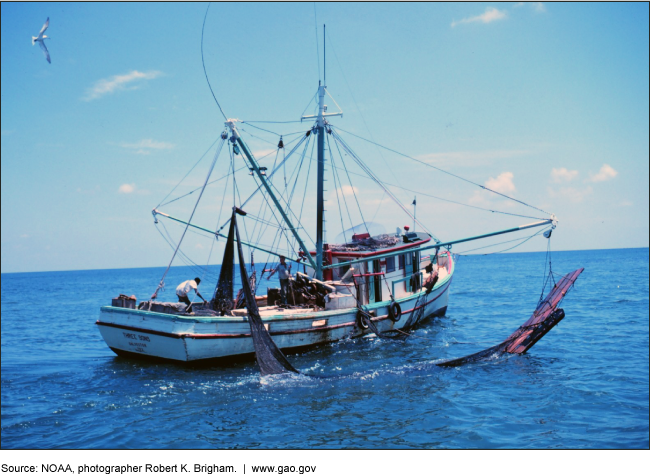Forced Labor: Better Communication Could Improve Trade Enforcement Efforts Related to Seafood
Fast Facts
Forced labor is a global problem affecting millions of people, according to the United Nations. U.S. law prohibits imports produced with forced labor, including seafood.
Customs and Border Protection, responsible for enforcement, established a forced labor division in 2018 to focus on identifying such imports.
CBP uses information from external sources to help identify seafood imports produced with forced labor, but may be missing opportunities to obtain information from those sources. We recommended that CBP better communicate the types of information these sources could collect and submit to CBP, to help with its enforcement efforts.

fishing vessel
Highlights
What GAO Found
The Department of Homeland Security's U.S. Customs and Border Protection (CBP) uses a four-phase process to enforce section 307 of the Tariff Act of 1930, which prohibits imports produced with forced labor, including seafood. CBP's Forced Labor Division, established in 2018, largely carries out this process. In phase 1, CBP assesses leads when deciding to initiate a case involving potential forced labor. In phase 2, CBP investigates cases using a variety of information to determine whether evidentiary standards have been met. In phase 3, CBP reviews information for legal sufficiency and, in phase 4, may take action at a port of entry to detain imports in violation by issuing a withhold release order. Between 2016 and March 2020, CBP issued one order for seafood, prohibiting tuna shipments from a specific fishing vessel from entering U.S. commerce.
Imported Goods Await Inspection by U.S. Customs and Border Protection at a Port of Entry

CBP uses information from external sources to help enforce section 307 for seafood imports but may miss opportunities to obtain key information from stakeholders. CBP officials said they use media reports and information from federal agencies and stakeholders to develop forced labor cases. For example, CBP initiated the case that resulted in the seafood order based partly on media reports and investigated it using vessel data from the Department of Commerce. CBP officials said that stakeholders such as nongovernmental organizations (NGOs) often have firsthand accounts of forced labor—valuable information for investigations. However, most stakeholders told GAO that they do not have a clear understanding of the information CBP needs to investigate seafood cases because CBP has not communicated such information. For example, CBP's website provides general information about what individuals can submit if forced labor is suspected but does not provide specific types of information that could be useful. With better communication to stakeholders about the types of information it needs to develop forced labor cases, CBP may be able to improve its enforcement efforts.
Why GAO Did This Study
The United States, which relies on imports for most of the seafood it consumes, imported about $40 billion in fishery products in 2018. Seafood imports often involve complex supply chains, which may include forced labor. A 2017 United Nations report estimated that there are 24.9 million people in forced labor around the world, 12 percent of whom work in the agriculture and fishing sectors.
Section 307 of the Tariff Act of 1930, as amended in 2016, prohibits the importation of goods, including seafood, produced or manufactured, wholly or in part, in any foreign country by forced labor, among other things.
GAO was asked to review CBP's enforcement of section 307. This report examines (1) the process CBP uses to enforce section 307 for seafood imports and the results of its civil enforcement actions; and (2) the external sources of information CBP uses to help carry out enforcement of section 307 for seafood imports and stakeholder perspectives on CBP's communication of its information needs. GAO reviewed laws and CBP documents pertaining to section 307 enforcement and interviewed officials from CBP, other federal agencies, and 18 NGO stakeholders. GAO selected NGOs with various goals and missions related to seafood and forced labor.
Recommendations
GAO recommends that CBP better communicate to stakeholders the types of information stakeholders could collect and submit to CBP to help the agency initiate and investigate forced labor cases related to seafood and, as appropriate, other goods. CBP agreed with GAO's recommendation.
Recommendations for Executive Action
| Agency Affected | Recommendation | Status |
|---|---|---|
| United States Customs and Border Protection | The Acting Commissioner of CBP should better communicate to stakeholders the types of information stakeholders could collect and submit to CBP to help the agency initiate and investigate forced labor cases related to seafood and, as appropriate, other goods. (Recommendation 1) |
As of November, 2021, the agency's forced labor website includes a link to a June 2020 report by the Human Trafficking Legal Center, which is described as a resource that may be used to help the trade community strengthen petitions to CBP. This report provides guidance for stakeholders alleging potential forced labor, including an overview of the core components of an allegation, including the types of evidence required and sources of information. Additionally, CBP officials discussed helpful information that can be included with an allegation at their June 2021 Civil Society Organization Round Table meeting.
|
